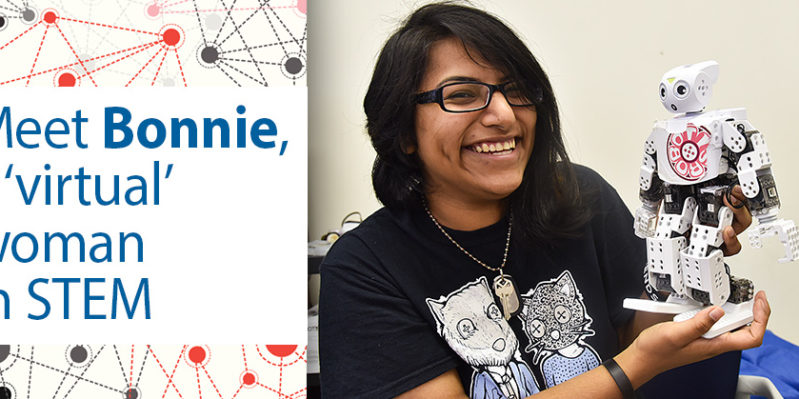
 CareerFocus: Our focus in this issue is women in STEM (science, technology, engineering, and math). Do you really fit in that category?
CareerFocus: Our focus in this issue is women in STEM (science, technology, engineering, and math). Do you really fit in that category?
Bonnie: Well, let’s see. My name is Bonnie. I love to dance, and I can curtsy. I can speak Javascript. I was programmed with Robotis Darwin Mini software. So, you do the math.
CF: LOL. Yeah, I can see how you do sort of classify as a “virtual” woman in STEM. Now, let’s have some bio info. When were you…er…born (or assembled, or whatever)?
Bonnie: Kiani Johnson, a San Jacinto College student, assembled and programmed me in November 2014. She is studying animal science, but got interested in robotics by visiting the San Jacinto College computer lab.
CF: Interesting. I would not think animal science would typically be linked with robotics.

Jalyssa Trevino and other San Jacinto College math and engineering students use calculus, trigonometry, computer science, and other critical thinking skills by building and programming robotic devices like Bonnie.
Photo credit: Rob Vanya, San Jacinto College marketing, public relations, and government affairs department.
Bonnie: Actually, the field of robotics is ever expanding and it’s not too far-fetched to envision the use of robotic devices in animal science. In fact, when Kiani put me together she learned a lot about an engineering concept called biomimicry, which fuses biology and technology, and modern animal science combines biology and technology.
CF: Good point. What are some other math and engineering concepts used by students when they work in the San Jacinto College computer lab?
Bonnie: Regarding math, they use a lot of trigonometry and calculus. As to engineering concepts, they use mechanical engineering, electrical engineering, and computer science. It’s really an interesting and interactive learning environment in our computer lab. It’s not just a professor lecturing students about complex math and engineering concepts. The students are directly involved. They apply math and engineering concepts quite naturally without really thinking about it. It’s very hands-on and engaging.
CF: What sort of attributes do many women possess that you feel enables them to excel in math and engineering?
Bonnie: We are naturally good at communication, which is an important skill for completing math and engineering projects. We also pay close attention to detail, another critical math and engineering skill. We also are generally very organized. For example, female students in the computer lab came up with a color code scheme for organizing parts and equipment. Oh, and speaking of color, some students in the computer lab are working on a cool project that I am excited about.
CF: What is it?
Bonnie: They are using their own handmade 3-D printer to make spare parts for me and other robotic devices. That means I will soon have some new pink shoes to wear. Is that cool, or what?
CF: That’s way cool. Leave it to a lady robot to get excited about accessorizing the wardrobe. In conclusion, do you have any women in STEM heroines?
Bonnie: Yes, I admire Margaret Hamilton, a pioneer in computer science and software development. She was on the team that pioneered the Apollo on-board guidance software that enabled man to make the first landing on the Moon. Margaret first coined the term “software engineering” when computer science and software engineering were not yet disciplines. She once served as Director of the Software Engineering Division of the MIT Instrumentation Laboratory. In 2003, NASA presented Margaret the Exceptional Space Act Award for scientific and technical contributions, which included $37,200, the largest amount awarded to any individual in NASA’s history. I sometimes wonder where mankind would be if it weren’t for innovative women like Margaret. Her success story ought to inspire young women interested in math and engineering to apply themselves and do great things.
– Rob Vanya
